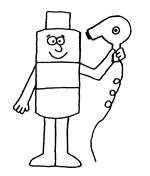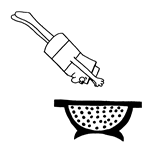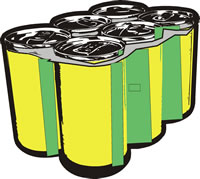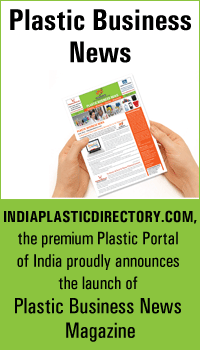|
It's Plastic
Decoding Plastics
Disposing of Plastic
Recycling Plastics
How Plastic is Recycled
Energy from Plastic
Paper or Plastic?
Degradable Plastic
IT'S PLASTIC!
 Americans
seem to have a love�hate affair with plastic. We look down on plastic imitations
of natural products and fibers. They are cheap, we say. We all want real
leather, for example, rather than imitation plastic. Americans
seem to have a love�hate affair with plastic. We look down on plastic imitations
of natural products and fibers. They are cheap, we say. We all want real
leather, for example, rather than imitation plastic.
Yet we are using plastic products more than ever before. We cover our food in
plastic wrap, drink coffee from Styrofoam� cups, wear clothes made from man-made
fibers like nylon, polyester, and rayon, and even buy our plastic things with
plastic credit cards! We use plastic hundreds of times every day.
Plastic is a versatile product. Plastic can be flexible or rigid; transparent
or opaque. It can look like leather, wood, or silk. It can be made into toys or
heart valves. Altogether there are more than 10,000 different kinds of plastics.
The basic raw materials for plastic are petroleum and/or natural gas. These
fossil fuels are sometimes combined with other elements, such as oxygen or
chlorine, to make different types of plastic.
Plastics are not the waste and energy culprits that some people think they
are. Plastics are really very energy efficient. It takes 20-40 percent less
energy to manufacture plastic grocery bags than paper ones. And, since plastics
are lightweight and take up so little space, it is much more efficient to
transport them. It takes seven trucks to deliver the same number of paper bags
as can be carried in one truckload of plastic bags.
DECODING PLASTICS
 PET
Polyethylene Terephthalate PET
Polyethylene Terephthalate
Two-liter beverage bottles, mouthwash bottles, boil-in-bag pouches.
 HDPE
High Density Polyethylene HDPE
High Density Polyethylene
Milk jugs, trash bags, detergent bottles.
 PVC Polyvinyl Chloride
PVC Polyvinyl Chloride
Cooking oil bottles, packaging around meat.
 LDPE
Low Density Polyethylene LDPE
Low Density Polyethylene
Grocery bags, produce bags, food wrap, bread bags.
 PP
Polypropylene PP
Polypropylene
Yogurt containers, shampoo bottles, straws, margarine tubs, diapers.
 PS
Polystyrene PS
Polystyrene
Hot beverage cups, take-home boxes, egg cartons, meat trays, cd cases.
 OTHER OTHER
All other types of plastics or packaging made from more than one type of
plastic.
DISPOSING OF PLASTIC
|
ANOTHER look |
|
PLASTICS RECYCLING IN AMERICA |
Today, Americans recycle only 5 percent of all the plastics produced in
this country. Why aren�t we recycling more? There is no simple answer.
Part of the issue in recycling plastics is the cost. To remain
competitive in the global marketplace, manufacturers usually choose the
cheapest option for making products. New plastic resin, or virgin resin,
often costs less than recycled plastic. Until recently, when the U.S,
experienced massive hurricanes, virgin resin was cheaper than recycled
plastic. After the hurricanes in 2005, supplies of oil and natural gas--the
building blocks of virgin resins--became limited and more expensive. Prices
for virgin resin soared, and the demand for recycled plastics increased.
Another important consideration is human behavior. Surveys conducted by
Proctor & Gamble and other companies show that while most people expect
their plastic to be recycled, they won't go out of their way or pay a few
cents more to buy products made of recycled plastic.
There are success stories in plastics recycling, nonetheless. Soft-drink
bottles made of polyethylene terephthalate (PET) can be melted down and made
into carpet, t-shirts, stuffing for ski jackets, or molded into bottles
again. In 1999, Ford Motor Company used more than 60 million 2-liter plastic
soda bottles (7.5 million pounds) to make grille reinforcements, window
frames, engine covers and trunk carpets for its new vehicles.

In recent years, several plastics recycling companies have closed their
doors. They claimed they could not sell their products at a price that would
allow them to stay in business. Thanks to the relatively low cost of
petroleum today, the price of virgin plastic is so inexpensive that recycled
plastic cannot compete. The price of virgin resin is about 40 percent lower
than that of recycled resin.
Because recycled plastic is more expensive, people aren�t exactly lining
up to buy it. Surveys conducted by Procter & Gamble and others show that
while most people expect their plastic to be recycled, they won�t go out of
their way or pay a few cents more to buy a bottle made of recycled plastic.
Recyclers say plastics recycling won�t be profitable until we close the loop
by creating more demand for recycled plastics.
Soft-drink bottles, however, are one success story in plastics recycling.
Made of polyethylene terephthalate (PETE), they can be melted down and made
into carpet, t-shirts, stuffing for ski jackets, or molded into bottles
again. When a soft-drink bottle is recycled into another soft-drink bottle,
the loop is closed.
|
Is plastic trash choking the Earth with Styrofoam� cups and fast-food plates?
Not really. That�s just another misconception. By weight, plastics make up about
11 percent of America�s municipal solid waste. In comparison, paper makes up
about 35 percent.
Of course, plastics are generally very lightweight. When plastics are buried
in a landfill, they occupy about 25 percent of the space. Putting plastics into
landfills is not always the best disposal method. There are two other
alternatives: recycling and incineration.
These methods recover some of the value from the plastic. Recycling recovers
the raw material, which can then be used to make new plastic products.
Incineration recovers the chemical energy, which can be used to produce steam
and electricity. Landfilling plastics does neither of these things. The value of
landfilled plastic is buried forever.
RECYCLING PLASTICS
Recycling plastics is easy. First, you should learn what types of plastics
can be recycled and only give your collector those types of plastics.
Resist the temptation to slip plastics that recyclers don�t want into the
recycling bin. Plastics have different formulations and should be sorted before
they are recycled to make new products. Mixed plastics can be recycled, but they
are not as valuable as sorted plastics because the recycled plastic�s physical
properties, such as strength, may vary with each batch.
Once you know what kinds of plastics your recycler wants, you should follow
the wash and squash rule�rinse the container and squash it. You may leave the
paper labels on the container, but throw away the plastic caps. Plastic caps are
usually made from a different type of plastic than the container and cannot be
easily recycled.
HOW PLASTIC IS RECYCLED
A recycling plant uses seven steps to turn plastic trash into recycled
plastic:
 1.
Inspection 1.
Inspection
Workers inspect the plastic trash for contaminants like rock and glass, and for
plastics that the plant cannot recycle.
 2.
Chopping and Washing 2.
Chopping and Washing
The plastic is washed and chopped into flakes.
 3.
Flotation Tank 3.
Flotation Tank
If mixed plastics are being recycled, they are sorted in a flotation tank, where
some types of plastic sink and others float.
 4.
Drying 4.
Drying
The plastic flakes are dried in a tumble dryer.
 5.
Melting 5.
Melting
The dried flakes are fed into an extruder, where heat and pressure melt the
plastic. Different types of plastics melt at different temperatures.
 6.
Filtering 6.
Filtering
The molten plastic is forced through a fine screen to remove any contaminants
that slipped through the washing process. The molten plastic is then formed into
strands.
 7.
Pelletizing 7.
Pelletizing
The strands are cooled in water, then chopped into uniform pellets.
Manufacturing companies buy the plastic pellets from recyclers to make new
products. Recycled plastics also can be made into flowerpots, lumber, and
carpeting.
ENERGY FROM PLASTIC
Because plastics are made from fossil fuels, you can think of them as another
form of stored energy. Pound for pound, plastics contain as much energy as
petroleum or natural gas, and much more energy than other types of garbage. This
makes plastic an ideal fuel for
waste-to-energy plants.
Waste-to-energy plants burn garbage and use the heat energy released during
combustion to make steam or electricity. They turn garbage into useful energy.
So, should we burn plastics or recycle them? It depends. Sometimes it takes more
energy to make a product from recycled plastics than it does to make it from
all-new materials. If that�s the case, it makes more sense to burn the plastics
at a waste-to-energy plant than to recycle them. Burning plastics can supply an
abundant amount of energy, while reducing the cost of waste disposal and saving
landfill space.
PAPER OR PLASTIC?
A paper cup or a plastic cup? Should you choose paper cups over plastic cups
since the paper cups are made from natural wood products and will degrade? Not
if the plastic cup is polystyrene (another name for Styrofoam�).
A study by Canadian scientist Martin Hocking shows that
making a paper cup uses as much petroleum or natural gas as a polystyrene cup.
Plus, the paper cup uses wood pulp. The Canadian study said, �The paper cup
consumes 12 times as much steam, 36 times as much electricity, and twice as much
cooling water as the plastic cup.� And because the paper cup uses more raw
materials and energy, it also costs 2.5 times more than the plastic cup. But the
paper cup will degrade, right? Probably not. Modern landfills are designed to
inhibit degradation so that toxic wastes do not seep into the surrounding soil
and groundwater. The paper cup will still be a paper cup 20 years from now.
DEGRADABLE plastic
Degrade is another word for rot. It�s nature�s way of getting rid of dead
plants and animals or the things made from them. Of course, plastics are
man-made materials, but scientists have figured out two ways to make plastics
degrade: biodegradation and photodegradation.
Biodegradable plastics are made with five percent cornstarch or vegetable
oil. The idea is that hungry bacteria will devour the starch or oil in the
plastic, causing the plastic to disintegrate into a fine dust. That is the idea,
but does it really work?
No, say both environmentalists and plastics manufacturers. Nothing degrades
quickly in a modern landfill, not even organic wastes like paper and food
scraps, so there is no reason to think that the corn starch in biodegradable
plastics will disappear overnight either. Modern landfills are designed to
inhibit degradation, not promote it. The idea is to keep wastes in, so landfill
contaminants do not seep into the surrounding environment. In addition,
biodegradable plastics cannot be recycled because the starch or oil additive
compromises the quality of recycled plastics.
Photodegradable plastics are a different matter. They use no organic
additives. They are made with a special type of plastic that breaks down and
becomes brittle in the presence of sunlight. Of course, that means
photodegradable plastics do not break down when they are covered by leaves or
snow, or when they are buried in a landfill.
 The
maker of the plastic six-ring carrier that is used to attach six cans of soda,
beer, and other beverages, says its photodegradable carrier loses 75 percent of
its strength when exposed to sunlight after just a few days, and totally
disintegrates within a matter of weeks. This means if an animal were to become
entangled in the six-ring carrier, it could rip through the weakened pack to
free itself. Since photodegradable plastics contain no organic additives, they
can also be recycled, unlike their biodegradable cousins. The
maker of the plastic six-ring carrier that is used to attach six cans of soda,
beer, and other beverages, says its photodegradable carrier loses 75 percent of
its strength when exposed to sunlight after just a few days, and totally
disintegrates within a matter of weeks. This means if an animal were to become
entangled in the six-ring carrier, it could rip through the weakened pack to
free itself. Since photodegradable plastics contain no organic additives, they
can also be recycled, unlike their biodegradable cousins.
Source:
National Energy Education Development Project, Museum of Solid Waste ,
2006
| 

 Plastics Engineering
Plastics Engineering Americans
seem to have a love�hate affair with plastic. We look down on plastic imitations
of natural products and fibers. They are cheap, we say. We all want real
leather, for example, rather than imitation plastic.
Americans
seem to have a love�hate affair with plastic. We look down on plastic imitations
of natural products and fibers. They are cheap, we say. We all want real
leather, for example, rather than imitation plastic.  PET
Polyethylene Terephthalate
PET
Polyethylene Terephthalate  HDPE
High Density Polyethylene
HDPE
High Density Polyethylene  PVC Polyvinyl Chloride
PVC Polyvinyl Chloride  LDPE
Low Density Polyethylene
LDPE
Low Density Polyethylene  PP
Polypropylene
PP
Polypropylene  PS
Polystyrene
PS
Polystyrene  OTHER
OTHER

 1.
Inspection
1.
Inspection  2.
Chopping and Washing
2.
Chopping and Washing  3.
Flotation Tank
3.
Flotation Tank  4.
Drying
4.
Drying  5.
Melting
5.
Melting  6.
Filtering
6.
Filtering  7.
Pelletizing
7.
Pelletizing  The
maker of the plastic six-ring carrier that is used to attach six cans of soda,
beer, and other beverages, says its photodegradable carrier loses 75 percent of
its strength when exposed to sunlight after just a few days, and totally
disintegrates within a matter of weeks. This means if an animal were to become
entangled in the six-ring carrier, it could rip through the weakened pack to
free itself. Since photodegradable plastics contain no organic additives, they
can also be recycled, unlike their biodegradable cousins.
The
maker of the plastic six-ring carrier that is used to attach six cans of soda,
beer, and other beverages, says its photodegradable carrier loses 75 percent of
its strength when exposed to sunlight after just a few days, and totally
disintegrates within a matter of weeks. This means if an animal were to become
entangled in the six-ring carrier, it could rip through the weakened pack to
free itself. Since photodegradable plastics contain no organic additives, they
can also be recycled, unlike their biodegradable cousins. 


 Knowledge Base
Knowledge Base

















 Knowledge Base
Knowledge Base


